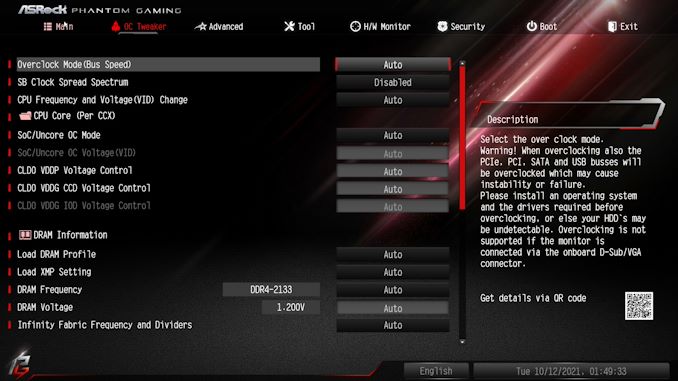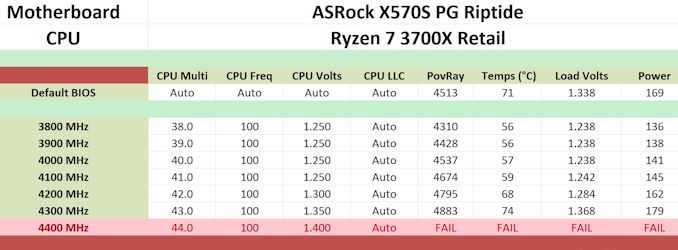The ASRock X570S PG Riptide Motherboard Review: A Wave of PCIe 4.0 Support on A Budget
by Gavin Bonshor on October 22, 2021 9:00 AM ESTOverclocking Ryzen 3000
Experience with the ASRock X570S PG Riptide
Despite AMD's Ryzen 5000's presence on the current market and support for these across various AM4 chipsets, we do all of our AM4 testing with the Ryzen 7 3700X processor for consistency. Overclocking can yield many benefits in performance, but at the drawback of extra heat and power. This is a consequence of adding more CPU VCore. (It should also be noted that right now I do not have a 5950X for motherboard testing, but as we've used this 3700X for so many AM4 boards in the past, we know its characteristics quite well - an overclocking motherboard should also be able to push other CPUs than just the flagships too).
Most power delivery is over-engineered to support the latest processors, however hot they run. This is a continuance of CPU vendors constantly pushing default and turbo clocks, pushing the silicon to its limits. Anyone looking to overclock will need to consider more aggressive cooling types such as hefty premium AIOs.
All of ASRock's overclocking options can be found within the OC Tweaker section of the firmware, with plenty of options to overclock the processor, memory, and integrated graphics on Ryzen APUs. ASRock has all the options present in a long list, with some sub-sections for things like memory latencies and power options. Users looking to overclock the CPU can do so by setting the CPU Frequency and CPU VCore voltage which is located third from the top in the above BIOS image. Other options include setting the Loadline Calibration level for more aggressive or conservative VDroop on the CPU VCore, although users could leave this on automatic.
There's also plenty of options to overclock memory including latency timing options, as well as the ability to just simply enable X.M.P 2.0 profiles on compatible kits of memory. When overclocking the memory on Ryzen, users can adjust the Infinity Fabric Clock speed (FCLK) with the best results achieved by setting a 2:1 ratio in terms of the memory speed, e.g, DDR4-3600 at an FCLK of 1800 MHz.
Overclocking with the ASRock X570S PG Riptide is simple to do. There are fewer options than expected when compared to more premium models, but for the price point, there's plenty to like from an overclocking point of view here.
Overclocking Methodology
Our standard overclocking methodology is as follows. We select the automatic overclock options and test for stability with POV-Ray and OCCT to simulate high-end workloads. These stability tests aim to catch any immediate causes for memory or CPU errors.
For manual overclocks, based on the information gathered from the previous testing, start off at a nominal voltage and CPU multiplier. The multiplier is increased until the stability tests are failed. The CPU voltage is increased gradually until the stability tests are passed. The process is repeated until the motherboard reduces the multiplier automatically (due to safety protocol) or the CPU temperature reaches a stupidly high level (105ºC+). Our testbed is not in a case, which should push overclocks higher with fresher (cooler) air.
We use and overclock with the Ryzen 7 3700X on AM4 for consistency to compare with previous models in our previous overclocking testing.
Overclocking Results
Overclocking our AMD Ryzen 7 3700X with the ASRock X570S PG Riptide showed that despite its price tag, it has plenty about it. The PG Riptide has no preset overclocking profiles for us to test, but it performed well in our frequency testing from 3.8 GHz to 4.3 GHz. We managed to achieve a maximin stable overclock of 4.3 GHz at 1.350 V on the CPU VCore, which is quite formidable for a board such as this.
Going from 3.8 GHz to 4.3 GHz, we observed relatively tight CPU VCore VDroop at full-load, and this was consistent throughout all of our testing. This is because when users change the CPU VCore within the firmware, it automatically sets the Loadline Calibration level to the highest level which is Level 1. As we went up every 100 MHz stepping in our testing, so did the performance in POV-Ray which is consistent with other results from other models we've tested with the same hardware configuration.
Overall overclocking on the ASRock X570S PG Riptide surprised us a little, as it performs just as well as other models both around the same price point and models above it in the stack.












39 Comments
View All Comments
Threska - Sunday, October 24, 2021 - link
Nothing says "canary" as a precursor to the fall of society as the decline of social skills. Soon we all will be communicating in the language of "road-rage".Spunjji - Monday, October 25, 2021 - link
I certainly think education on critical thinking would be of use, but I'm not so sure about fallacies specifically - your example is instructive here, as when lawyers use fallacies, they tend to do so in full knowledge of what they're doing. The target audience are likely to assess the information according to their priors - knowing that they've been presented with a fallacy is unlikely to sway them if they happen to agree with the conclusion.We saw this recently in the UK with a court decision (now overturned) that barred prescribing puberty blockers to trans children on the basis of an assumption that correlation entails causality; whenever this was pointed out people tended to respond by insisting that it was still the right decision for some other (usually unproven or false) reason.
Education on critical thinking is sorely lacking. I didn't get a grounding in subjects like formal logic and epistemology until I studied Philosophy as an undergraduate (I'm in the UK and was educated in a state school, for context).
Oxford Guy - Friday, October 29, 2021 - link
Enough education on fallacies would, hopefully, get them removed from serious discourse. The audience of lawyers is not only the highly-educated. Also, even those with advanced degrees are often only given cursory training in fallacies. The cram-then-forget style of so much of higher education is part of the problem. There is also pressure on all people in a society dominated by fallacies to cave.‘Critical thinking’ should also be reframed as ‘true thinking’ or similar — to remove the false implication that ‘critical’ thinking is special (therefore optional/compartmentalized) rather than the only kind of thinking that yields accurate understanding.
Another massive problem is bad terminology, terminology that so often enables people to avoid the rigor of rationality. When people hear of ‘critical thinking’ they are inclined to believe it’s an academic exercise rather than the way thinking should be approach generally. The embedded word critic also implies combativeness, an excessively-judgmental mentality. Given the strong appeal of conformity (i.e. being ‘chill’), such connotations are counterproductive.
opinali - Saturday, October 23, 2021 - link
The problem with this idea is the economics. If we make the Cartesian product of all CPU models even within a class, all motherboard models, RAM and SSD capacities, plus other variants that exist already (high-end Ethernet or not etc.), that's a truckload of possible SKUs. Unless you pick a one size fits all choice.TheinsanegamerN - Saturday, October 23, 2021 - link
I've got a better idea, what if we made a stqandard that would allow people to put in what they want/need at a price they are comfortable with? Oh hey, we already have that!If you want non upgradeable e-waste, and putting a CPU in a mobo is that hard for you, apple is already available for you. What would soldering everything even gain for you, outside of making everything permanent?
Oxford Guy - Saturday, October 23, 2021 - link
What has been needed for many many years is a change from the ATX form factor to one that cools GPUs efficiently.It has long been utterly ridiculous that the highest-power item in a machine spews its heat back into the case and has tiny fans to cool it.
Threska - Sunday, October 24, 2021 - link
There's change out there. Just not in the market most play in.https://youtu.be/chNM_nntwKU
Spunjji - Monday, October 25, 2021 - link
Yeah, this situation is bizarre. We're long overdue for a substantial change to system form-factor.Calin - Monday, October 25, 2021 - link
Intel introduced BTX 20 or so years ago.There is the ITX, miniITX, MicroATX, all the "small form factors", Intel's "Next Unit of Computing" (NUC), and so on and so forth.
I remember BTX being intended to support better cooling - but for that you have the cases with rotated mainboard, ports on top, multiple chambers (PSU separated from the rest), ...
Not to mention the fact that laptops are taking over desktops (with multiple form factors, from 13" and under laptops to 17.3" gaming rigs or engineering workhorses)...
A system form factor change is taking place...
Oxford Guy - Friday, October 29, 2021 - link
I was aware of BTX but don’t recall that it was mainly about getting GPU waste heat under better control. Perhaps it was. It has been a long time. AMD, Silverstone, Apple have also introduced other form factors. Regardless, the ATX form factor has remained dominant for far far too long.